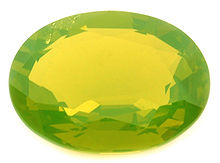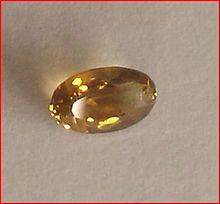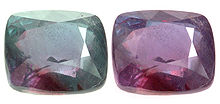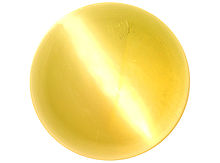- Chrysoberyl
-
Chrysoberyl 
General Category Oxide minerals - Spinel group Chemical formula BeAl2O4 Strunz classification 04.BA.05 Crystal symmetry Orthorhombic 2/m2/m2/m dipyramidal Unit cell a = 5.481 Å, b = 9.415 Å, c = 4.428 Å; Z = 8 Identification Color Various shades of green, yellow, brownish to greenish black, may be raspberry-red under incandescent light when chromian; colorless, pale shades of yellow, green, or red in transmitted light Crystal habit Crystals tabular or short prismatic, prominently striated Crystal system Orthorhombic Twinning Contact and penetration twins common, often repeated forming rosette structures Cleavage Distinct on (110), imperfect on (010), poor on {001} Fracture Conchoidal to uneven Tenacity Brittle Mohs scale hardness 8.5 Luster Vitreous Streak White Specific gravity 3.5 - 3.84 Optical properties Biaxial (+) Refractive index nα=1.745 nβ=1.748 nγ=1.754 Pleochroism X = red; Y = yellow-orange; Z = emerald-green 2V angle Measured: 70° References [1][2][3] Major varieties Alexandrite Color change; green to red Cymophane Chatoyant The mineral or gemstone chrysoberyl is an aluminate of beryllium with the formula BeAl2O4.[3] The name chrysoberyl is derived from the Greek words χρυσός chrysos and βήρυλλος beryllos, meaning "a gold-white spar". Despite the similarity of their names, chrysoberyl and beryl are two completely different gemstones. Chrysoberyl is the third-hardest frequently encountered natural gemstone and lies at 8.5 on the hardness scale, between corundum (9) and topaz (8).[4]
An interesting feature of its crystals are the cyclic twins called trillings. These twinned crystals have a hexagonal appearance, but are the result of a triplet of twins with each "twin" oriented at 120o to its neighbors and taking up 120o of the cyclic trilling. If only two of the three possible twin orientations are present, a "V"-shaped twin results.
Ordinary chrysoberyl is yellowish-green and transparent to translucent. When the mineral exhibits good pale green to yellow color and is transparent, then it is used as a gemstone. There are three main varieties of chrysoberyl: ordinary yellow-to-green chrysoberyl, cat's eye or cymophane, and alexandrite. Yellow-green chrysoberyl was referred to as "chrysolite" during the Victorian and Edwardian eras, which caused confusion since that name has also been used for the mineral olivine ("peridot" as a gemstone); that name is no longer used in the gemological nomenclature.
Alexandrite, a strongly pleochroic (trichroic) gem, will exhibit emerald green, red and orange-yellow colors depending on viewing direction in partially polarised light. However, its most distinctive property is that it also changes color in artificial (tungsten/halogen) light compared to daylight. The color change from red to green is due to strong absorption of light in a narrow yellow portion of the spectrum, while allowing large bands of blue-greener and red wavelengths to be transmitted. Which of these prevails to give the perceived hue depends on the spectral balance of the illumination. Typically, alexandrite has an emerald-green color in daylight (relatively blue illumination of high color temperature) but exhibits a raspberry-red color in incandescent light (relatively yellow illumination).
Cymophane is popularly known as "cat's eye". This variety exhibits pleasing chatoyancy or opalescence that reminds one of an eye of a cat. When cut to produce a cabochon, the mineral forms a light-green specimen with a silky band of light extending across the surface of the stone.
Contents
Occurrence
Chrysoberyl forms as a result of pegmatitic processes. Melting in the Earth's crust produces relatively low-density molten magma which can rise upwards towards the surface. As the main magma body cools, water originally present in low concentrations became more concentrated in the molten rock because it could not be incorporated into the crystallization of solid minerals. The remnant magma thus becomes richer in water, and also in rare elements that similarly do not fit in the crystal structures of major rock-forming minerals. The water extends the temperature range downwards before the magma sets solid completely, allowing concentration of rare elements to proceed so far that they produce their own distinctive minerals. The resulting rock, igneous in appearance but formed at a low temperature from a water-rich melt, with large crystals of the common minerals such as quartz and feldspar, but also with elevated concentrations of rare elements such as beryllium, lithium, or niobium, often forming their own minerals, is called a pegmatite. The high water content of the magma made it possible for the crystals to grow quickly, so pegmatite crystals are often quite large, which increases the likelihood of gem specimens forming.
Chrsoberyl can also grow in the country rocks near to pegmatites, when Be- and Al-rich fluids from the pegmatite react with surrounding minerals. Hence, it can be found in mica schists and in contact with metamorphic deposits of dolomitic marble. Because it is a hard, dense mineral that is resistant to chemical alteration, it can be weathered out of rocks and deposited in river sands and gravels in alluvial deposits with other gem minerals such as diamond, corundum, topaz, spinel, garnet, and tourmaline. When found in such placers, it will have rounded edges instead of sharp, wedge-shape forms. Much of the chrysoberyl mined in Brazil and Sri Lanka is recovered from placers as the host rocks have been intensely weathered and eroded.
If the pegmatite fluid is rich in beryllium, crystals of beryl or chrysoberyl could form. Beryl has a high ratio of beryllium to aluminium, while the opposite is true for chrysoberyl. Both are stable with the common mineral quartz. For alexandrite to form, some chromium would also have had to be present. However, beryllium and chromium do not tend to occur in the same types of rock. Chromium is commonest in mafic and ultramafic rocks in which beryllium is extremely rare. Beryllium becomes concentrated in felsic pegmatites in which chromium is almost absent. Therefore, the only situation where an alexandrite can grow is when Be-rich pegmatitic fluids react with Cr-rich country rock. This unusual requirement explains the rarity of this chrysoberyl variety.
Chrysoberyl
Chrysoberyl was discovered in 1789 and described and named by Abraham Gottlob Werner, in 1790. Werner worked at the Freiberg Mining Academy from 1790–1793 and was well known as one of the most outstanding geologists of his time. He is best known today as the loser in the battle of the Neptunists and Vulcanists that raged in the 1780s.[5]
Chrysoberyl is normally yellow, yellow-green, or brownish with its color being caused by the presence of iron. Spectroscopic analysis will usually reveal a strong band where the violet takes over from the blue. As the color darkens from bright yellowish-green to golden-yellow to brown, this band increases in strength. When the stone has a strong color, two additional bands can be seen in the green-blue. The most common inclusions are liquid-filled cavities containing three-phase inclusions. Stepped twin planes may be apparent in some cases. Some very rare minty bluish-green chrysoberyls from Tanzania owe their color to the presence of vanadium.
Despite the similarity of their names, chrysoberyl and beryl are two completely different gemstones. Members of the beryl group include emerald, aquamarine, and morganite while members of the chrysoberyl group include chrysoberyl, cymophane (cat's eye), and alexandrite. Beryl is a silicate and chrysoberyl is an oxide and although both beryl and chrysoberyl contain beryllium, they are separate gemstone species unrelated in any other way. Because of the confusion between chrysoberyl and beryl, chrysoberyl is relatively unknown in its own right and the alexandrite variety is much more widely recognized. The only well-known natural gemstones harder than chrysoberyl are corundum and diamond.
Alexandrite
The alexandrite variety displays a color change (alexandrite effect) dependent upon the nature of ambient lighting. This color shift is independent of any change of hue with viewing direction through the crystal that would arise from pleochroism. Both these different properties are frequently referred to as "color change", however. Alexandrite results from small scale replacement of aluminium by chromium ions in the crystal structure, which causes intense absorption of light over a narrow range of wavelengths in the yellow region of the spectrum.[citation needed] Alexandrite from the Ural Mountains in Russia is green by daylight and red by incandescent light. Other varieties of alexandrite may be yellowish or pink in daylight and a columbine or raspberry red by incandescent light.
According to a popular but controversial story, alexandrite was discovered by the Finnish mineralogist Nils Gustaf Nordenskiöld, (1792–1866) and named alexandrite in honor of the future Tsar Alexander II of Russia. Nordenskiöld's initial discovery occurred as a result of an examination of a newly found mineral sample he had received from Perovskii, which he identified as emerald at first. The first emerald mine had been opened in 1831.[6]
Alexandrite up to 5 carats (1,000 mg) and larger were traditionally thought to be found only in the Ural Mountains. Other deposits are located in India (Andhra Pradesh), Madagascar, and Sri Lanka. Alexandrite in sizes over 3 carats are very rare.
Some gemstones described as lab-grown (synthetic) alexandrite are actually corundum laced with trace elements (e.g., vanadium) or color-change spinel and are not actually chrysoberyl. As a result, they would be more accurately described as simulated alexandrite rather than synthetic but are often called Czochralski alexandrite after the process that grows the crystals.[citation needed]
Cymophane
Translucent yellowish chatoyant chrysoberyl is called cymophane or cat's eye. Cymophane has its derivation also from the Greek words meaning 'wave' and 'appearance', in reference to the chatoyancy sometimes exhibited. In this variety, microscopic tubelike cavities or needlelike inclusions [7] of rutile occur in an orientation parallel to the c-axis producing a chatoyant effect visible as a single ray of light passing across the crystal. This effect is best seen in gemstones cut in cabochon form perpendicular to the c-axis. The color in yellow chrysoberyl is due to Fe3+ impurities.
Although other minerals such as tourmaline, scapolite, corundum, spinel and quartz can form "cat's eye" stones similar in appearance to cymophane, the jewelry industry designates these stones as "quartz cat's eyes", or "ruby cat's eyes" and only chrysoberyl can be referred to as "cat's eye" with no other designation.
Gems lacking the silky inclusions required to produce the cat's eye effect are usually faceted. An alexandrite cat's eye is a chrysoberyl cat's eye that changes color. "Milk and honey" is a term commonly used to describe the color of the best cat's eyes. The effect refers to the sharp milky ray of white light normally crossing the cabochon as a center line along its length and overlying the honey colored background. The honey color is considered to be top-grade by many gemologists but the lemon yellow colors are also popular and attractive. Cat's eye material is found as a small percentage of the overall chrysoberyl production wherever chrysoberyl is found.
Cat's eye really became popular by the end of the 19th century when the Duke of Connaught gave a ring with a cat's eye as an engagement token; this was sufficient to make the stone more popular and increase its value greatly. Until that time, cat's eye had predominantly been present in gem and mineral collections. The increased demand in turn created an intensified search for it in Sri Lanka. Early 20th century prices could go up as high as $8000 for a cut stone.[8]
See also
References
- ^ Handbook of Mineralogy
- ^ Mindat.org
- ^ a b Webmineral data
- ^ Klein, Cornelis; and Cornelius S. Hurlbut, Jr. (1985). Manual of Mineralogy (20th ed. ed.). New York: Wiley. ISBN 0-471-80580-7.
- ^ Chapter 3: Species and variety. (2006, February 07). In Alexandrite.net, Tsarstone collectors guide. Retrieved online 06:45, February 26, 2007[unreliable source?]
- ^ Sinkankas, J (1984). Gem Cutting, A Lapidary's Manual. van Nostrom Reinhold.
- ^ "Mitchell, T. E. and Marder, J. M., "Precipitation in Cat's-Eye Chrysoberyl," Electron Microscopy Soc. Proceedings, 1982.
- ^ "U.S. Geological Survey, 1887 , George Frederick Kunz, Cymophane, Cat's Eye as gemstone". 1887. http://www.farlang.com/gemstones/us-geol-survey-1887/page_031. Retrieved 2007-07-09.
Jewellery Forms Anklet · Belt buckle · Belly chain · Bindi · Bracelet · Brooch · Chatelaine · Collar pin · Crown · Cufflink · Earring · Lapel pin · Necklace · Pendant · Ring · Tiara · Tie clip · Toe ring · Watch (pocket)Making PeopleProcessesCasting (centrifugal, lost-wax, vacuum) · Enameling · Engraving · Filigree · Metal clay · Plating · Polishing · Repoussé and chasing · Soldering · Stonesetting · Wire wrappingToolsMaterials Britannia silver · Colored gold · Crown gold · Electrum · Platinum sterling · Shakudo · Shibuichi · Sterling silver · TumbagaMineral gemstonesAventurine · Agate · Alexandrite · Amethyst · Aquamarine · Carnelian · Citrine · Diamond · Diopside · Emerald · Garnet · Jade · Jasper · Lapis lazuli · Larimar · Malachite · Marcasite · Moonstone · Obsidian · Onyx · Opal · Peridot · Quartz · Ruby · Sapphire · Sodalite · Sunstone · Tanzanite · Tiger's eye · Topaz · Tourmaline · TurquoiseOrganic gemstonesTerms Categories:- Beryllium minerals
- Aluminium minerals
- Spinel group
- Gemstones
- Orthorhombic minerals
Wikimedia Foundation. 2010.




